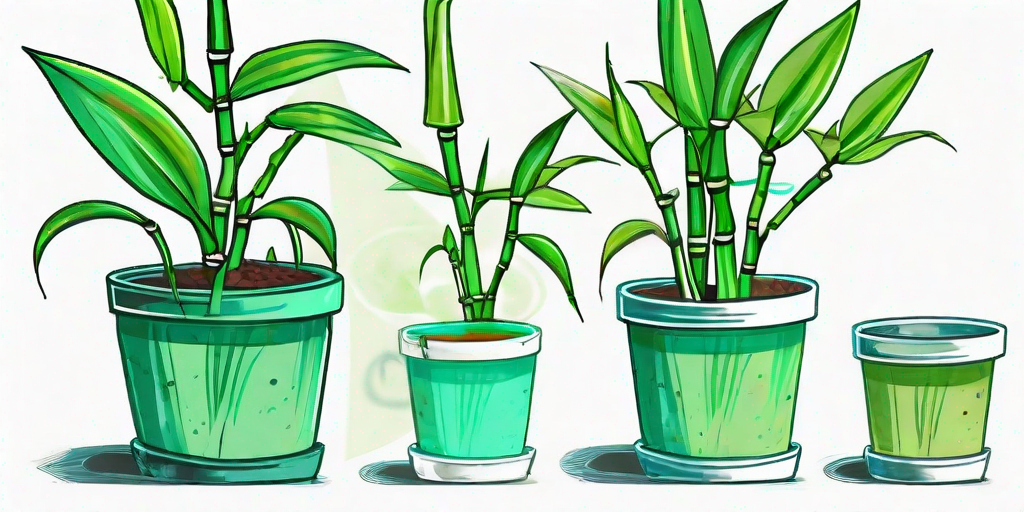
Lucky Bamboo, or as the botanists like to call it, Dracaena sanderiana, is a popular houseplant known for its resilience and striking appearance. But let's face it, even the luckiest bamboo can sometimes feel a bit under the weather. In this comprehensive guide, we'll delve into the dirty secrets of Lucky Bamboo care, and how you can keep your green friend both healthy and happy.
Understanding Your Lucky Bamboo
Before we dive into the nitty-gritty of plant care, it's important to understand what makes your Lucky Bamboo tick. Despite its name, Lucky Bamboo isn't actually a bamboo at all. It's a member of the Dracaena family, which means it's more closely related to the corn plant than to the pandas' favorite snack.
Native to the tropical rainforests of Africa and South America, Lucky Bamboo has adapted to survive in a variety of conditions. This adaptability is one of the reasons why it's such a popular houseplant. But just because it's hardy doesn't mean it doesn't have its preferences. Like a petulant child, Lucky Bamboo will let you know when it's not happy.
The Ideal Conditions for Lucky Bamboo
While Lucky Bamboo can tolerate a range of conditions, it prefers indirect light and temperatures between 65 and 95 degrees Fahrenheit. It's not a fan of drafts or sudden temperature changes, so keep it away from doors, windows, and air vents. If your Lucky Bamboo starts to look a bit peaky, it might be trying to tell you that it's not happy with its living conditions.
Despite its tropical origins, Lucky Bamboo doesn't like to be too wet. Overwatering is a common cause of Lucky Bamboo demise. It prefers its soil to be kept consistently moist, but not waterlogged. If the leaves start to turn yellow or brown, it's a sign that the plant is getting too much water.
The Dirty Secrets of Lucky Bamboo Care
Now that we've covered the basics, let's get into the dirty secrets of Lucky Bamboo care. It might seem like a low-maintenance plant, but there are a few tricks to keeping your Lucky Bamboo in tip-top condition.
Firstly, despite its name, Lucky Bamboo isn't a fan of direct sunlight. Too much sun can cause the leaves to scorch and turn yellow. If your plant is getting too much sun, try moving it to a shadier spot or using a sheer curtain to filter the light.
Feeding Your Lucky Bamboo
Lucky Bamboo isn't a big eater, but it does appreciate a little snack every now and then. A balanced liquid houseplant fertilizer diluted to half strength is perfect for this. Feed your Lucky Bamboo every month during the growing season (spring and summer) and every other month during the rest of the year.
But be careful not to overfeed your plant. Too much fertilizer can cause the leaves to turn yellow or brown. If this happens, stop feeding your plant and flush the soil with clean water to remove any excess fertilizer.
Pruning and Shaping Your Lucky Bamboo
One of the great things about Lucky Bamboo is that it's easy to shape and prune. You can create all sorts of interesting shapes and designs by simply cutting the stems and using wire or string to guide their growth.
When pruning your Lucky Bamboo, always use a sharp, clean pair of scissors or pruning shears. Cut just above a node (the point where a leaf joins the stem) and your plant will sprout new growth from this point. But remember, Lucky Bamboo is a slow grower, so be patient and don't expect instant results.
Common Lucky Bamboo Problems and How to Fix Them
Even with the best care, your Lucky Bamboo might encounter a few problems along the way. But don't worry, most of these issues are easy to fix.
Yellow leaves are a common problem and are usually a sign of overwatering or too much sunlight. If your plant's leaves are turning yellow, try moving it to a shadier spot and reducing the amount of water you give it.
Brown Tips on Lucky Bamboo
Brown tips on the leaves are often a sign of low humidity or too much fertilizer. Try misting your plant with water to increase humidity and reduce the amount of fertilizer you're using. If the problem persists, you might need to repot your plant in fresh soil.
Remember, Lucky Bamboo is a resilient plant and can usually bounce back from a bit of neglect. But if you want your plant to thrive, it's important to give it the care and attention it deserves.
Frequently Asked Questions
Why is my Lucky Bamboo turning yellow?
Yellow leaves are usually a sign of overwatering or too much sunlight. Try moving your plant to a shadier spot and reducing the amount of water you give it.
How often should I water my Lucky Bamboo?
Lucky Bamboo prefers its soil to be kept consistently moist, but not waterlogged. A good rule of thumb is to water your plant when the top inch of soil feels dry to the touch.
Can I grow Lucky Bamboo in water?
Yes, Lucky Bamboo can be grown in water. However, it's important to change the water every week to prevent the growth of algae and bacteria.
Conclusion
So there you have it, the dirty truth about Lucky Bamboo. With a bit of care and attention, you can keep your plant healthy and happy. Remember, every plant is unique and what works for one might not work for another. So don't be afraid to experiment and find what works best for your Lucky Bamboo.
Happy growing!















